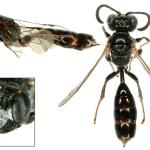Mimesa celtica SPOONER 1948; Psen fulvitaris GOSSAKOVSKIJ 1934; Psen fulvitaris GOSSAKOVSKIJ 1934 preocc.; Mimumesa unicolor misident.
This species is morphologically very similar to M. unicolor. Recent appraisals of the differences between these two species can be found in Else & Felton (1994) and a rigorous statistical examination in Budrys (2001). The species has been ascribed to the genus Psen in most previous literature, including Shirt (1987) and Falk (1991).
Traditionally, this species was thought to be restricted to coastal dunes in western Britain and eastern Ireland, e.g. Braunton Burrows in Devon, Oxwich Dunes, Glamorgan, Ainsdale in Lancashire and a confirmed record for Ireland from North Bull Island in Dublin Bay. However, during the 1980s G R Else collected a series of specimens from the Charmouth-Lyme Regis landslip.
Widely distributed in the Palaearctic region: generally scarce in Fennoscandia; also recorded from the Netherlands and Germany. In Asia it has been recorded from Mongolia, Manchuria (N.E. China) and Japan (Lomholdt 1984).
Listed in both Shirt (1987) and Falk (1991) as Rare (RDB3).
The majority of British and Irish records originate from dune systems, where the species is associated with the dry marram zone of the the "white dunes" (Else & Felton, 1994). The more recently found Charmouth-Lyme Regis population appears to be associated with typical undercliff habitats: damp, bare clay with sparse vegetation and seepages supporting common reed.
The earliest capture was on 16th June, although most records are from July and August, with records extending into late September.
Else & Felton (1994) cite Japanese research (Tsuneki, 1959) which indicates that prey are homopteran bugs within the families Cicadellidae and Delphacidae. This has been confirmed in Britain by G R Else, who found females carrying Chloronia species (Hemiptera: Delphacidae) and a nymph of a Macrostelus species (Hemiptera: Cicadellidae)(Else & Felton 1994).
Lomholdt (1984) appears to follow with tradition in speculating that the wasp may nest in the dead stems or roots of marram, but the most detailed nest description appears to be from Tsuneki (1959) who excavated burrows in a steep clay slope, perhaps reminiscent of the behaviour at Charmouth. Tsuneki found that the burrow could have one or more branches, with each branch having either a single terminal cell or a pair of cells. Once completed, the adjacent burrow was plugged with soil.
G M Spooner reported specimens on flowers of sea spurge (in Else & Felton 1994).
2005


